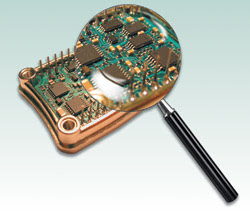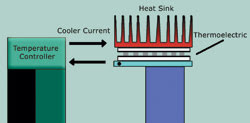Thermal design has limited further technological advances, but with new design tools and materials development in process, choices will emerge in the next few years.
Mary Knighton, Wavelength Electronics Inc.
Applications requiring temperature control can be divided into two camps: precision temperature control, where holding a fixed temperature is critical, and brute-force heat extraction, where the concern is ensuring that the temperature of a device does not exceed its damage threshold.
Examples of the first type include tuning and stabilizing laser diode wavelengths, increasing the lifetime and speed of passive telecommunications devices, calibrating and stabilizing detectors, and tuning frequency-doubling optics, for which stability to 0.001 °C is needed. High-power laser systems for welding, machining or printing are examples of the second, and require the removal of several watts of heat.
Optimizing the interaction of all the components in a system is important. Thermal simulator software can completely model the expected steady-state heat transfer to identify hot spots and to verify that sufficient cooling capacity exists. So far, this has not been coupled with transient modeling to determine how fast the device can be brought to temperature without overshoot or what the controller settings should be. This final optimization typically is performed empirically in the lab, with techniques such as Ziegler-Nichols tuning or with more sophisticated instruments that incorporate autotune algorithms.
One of the most rapidly changing aspects of the temperature control industry involves electronic controllers. Many OEM options are available off the shelf or integrated into optics packages. Manufacturers have been pressed to reduce size and cost while increasing efficiency. Higher-efficiency drivers avoid having to dissipate the heat in the first place. Custom-matched electronics can achieve greater than 90 percent efficiency, if the load impedance and current do not vary. This is difficult to achieve in an instrument designed for use with any load, but it may be possible when a design targets a specific application.

Fine-pitch and 0402 technology are used in a 1 × 1-in. Wavelength Electronics temperature controller. More than 100 parts are loaded on the circuit board. The “0402,” a standard package for resistors and capacitors, refers to the dimensions of the component parts; specifically, 0.004 × 0.002 in. — about the size of a flake of pepper.
Manufacturers have taken advantage of the industrywide drive to smaller electronics packages, such as 0201 or 0402 (referring to the dimensions of the component parts). Rather than being forced to develop a custom application-specific integrated circuit chip at a cost of $250,000 or more, meaningful size reductions can be achieved with fine-pitch parts and standard circuit board technology.
The use of standard technology also enables more-economical design changes. It can be challenging to find an assembly house capable of 0201, but 0402 is becoming more readily available.
Over the past 20 years, this trend in the electronics industry has led to smaller and faster electronic and electro-optical devices. But faster electronics create more heat, and smaller packages increase the heat density. Both aspects of increasing performance thus have driven traditional heat-transfer materials to their limits. Moore’s law of doubling CPU performance every 18 months is limited by maximum heat dissipation.
To compensate, processors are being split to enable the extraction of sufficient heat, and operating voltages are being reduced. Heat transfer “pipes” are being optimized through the use of more material, through the processing of surfaces so that they are rough and thereby offer a greater surface area to the air, and through the incorporation of bigger fans.
More research funding is going into the development of new materials for thermal transfer. An example is magnetic fluids, rather than water, in liquid transfer systems.
Competition for thermoelectrics also may exist. An example is a technology developed by Cool Chips plc of Gibraltar in which electrons transfer heat across a nanoscale gap.
Meet the author
Mary Knighton is CEO of Wavelength Electronics Inc. in Bozeman, Mont.; e-mail: [email protected].
Temperature Control: Back to Basics
A thermal system starts with an active or passive device that must be temperature-stabilized. Individual laser diodes typically incorporate a thermoelectric device to effect heat transfer and accurately stabilize the temperature and wavelength (see figure). Detectors or optics might employ a resistive heater to actively maintain temperature above ambient or the condensation point.
The choice of actuator is based on the amount of heat to be removed or added, the temperature stability required and the ambient conditions. Larger elements, such as laser diode bars, might require a water- or glycol-based heat-transfer actuator in which the fluid flows through a jacket directly mounted to the bar assembly. The liquid absorbs the heat and transfers it to a condenser/refrigerator unit to release it into the environment.

A precision temperature control setup may incorporate a thermoelectric actuator.
Rather than an external condenser, a thermoelectric unit pumps heat from its “cold side” to its “hot side.” Mounted to the hot side is a separate heat sink that completes the heat transfer to the environment.
Some hybrid systems use both a water jacket for bulk heat extraction and a thermoelectric element for better stability. Thermoelectrics today come in a myriad of shapes, sizes and power levels.
To drive the actuator, a closed-loop control system is typically used. A sensor feeds back the actual temperature of the device to the control electronics. This is compared with the user’s chosen set point, producing an error signal. The error signal then couples to an output stage with electronics appropriate to the actuator to drive the temperature to the set point.
Many controller choices are available based on one’s need for linearity, accuracy and stability. Both benchtop instruments and simple component temperature controllers are commercially available at costs ranging from tens of dollars to tens of thousands of dollars.